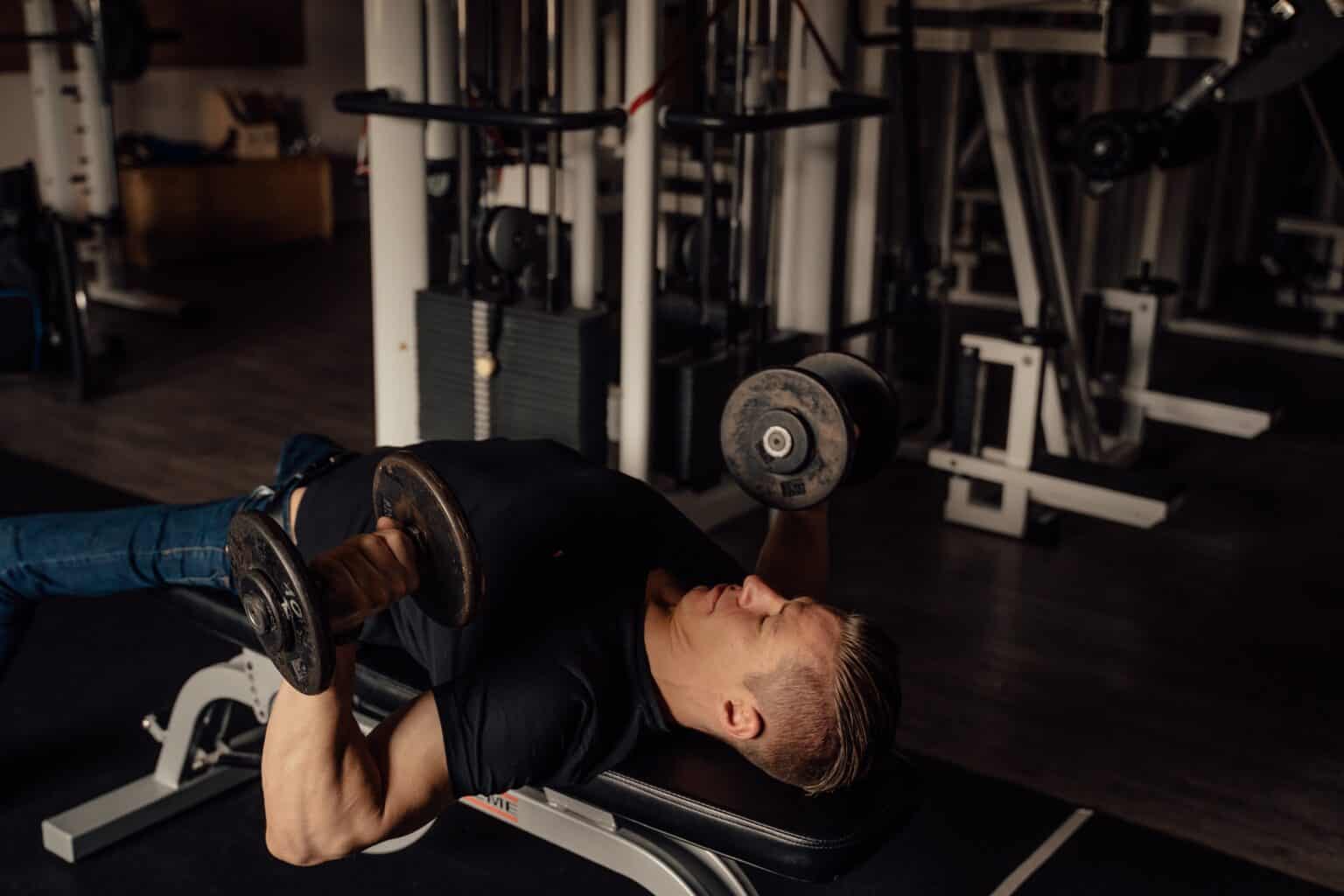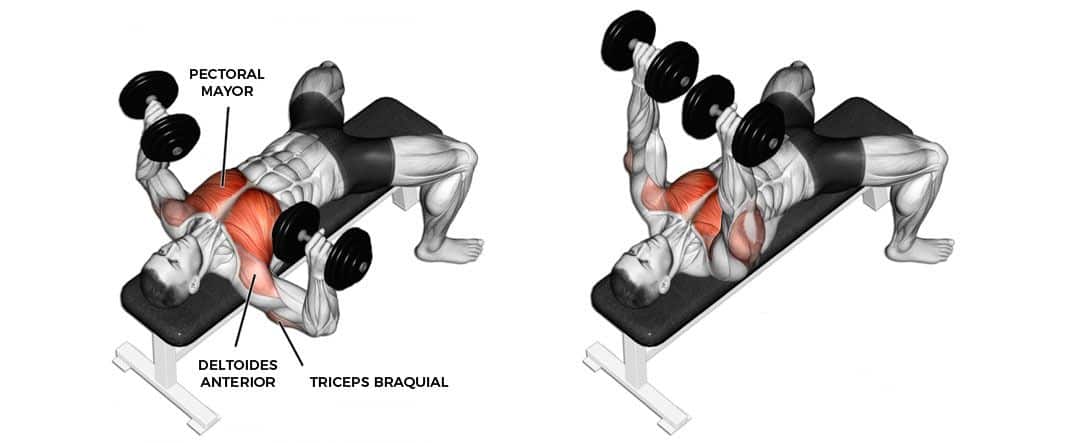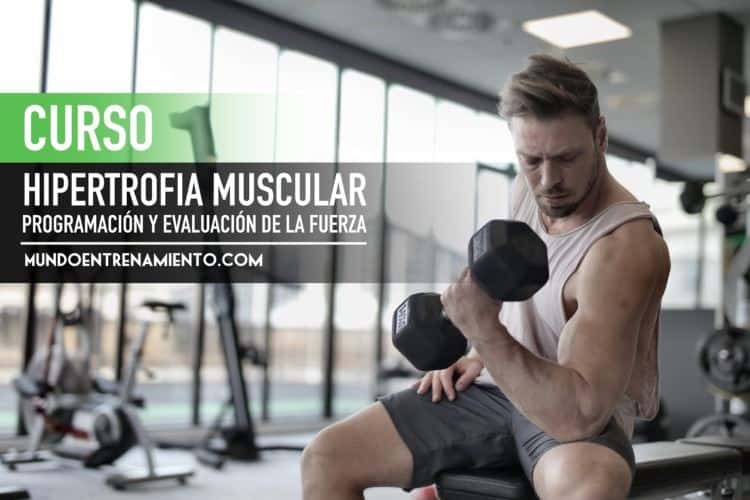The dumbbell press for the chest is a variant of the famous bench press. In this article, we will analyze muscle activation during the execution of the exercise and several important aspects to consider.
What is the dumbbell press?
The dumbbell press is an open kinetic chain exercise in which we primarily aim to work the different portions of the pectoralis major, the triceps, and the anterior deltoid.
The exercise is performed lying in a supine position on a bench, which can be executed at different inclines using dumbbells as equipment.
How to do a dumbbell press?
In the following section, we name the basic points to perform the dumbbell press correctly.
Initial position of the dumbbell press for the chest
The exercise begins lying in a supine position with the head, scapulae, and glutes supported on the bench.
We maintain a horizontal shoulder abduction and an elbow flexion of approximately 90º.
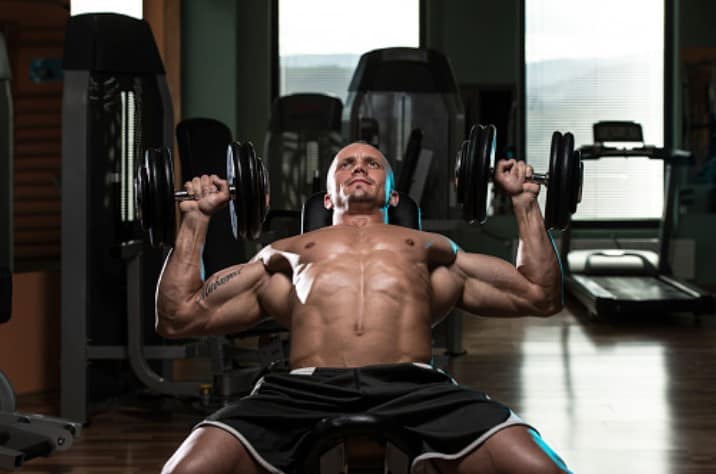
Execution phase
In the concentric phase, we must perform a horizontal adduction through a push that will end with the arms extended and a shoulder flexion of about 90º.
In the eccentric phase, we must slowly flex the elbows while retracting the scapulae to return to the initial position. It is important that the elbows remain aligned with the shoulders at the end of the movement.
How to place the dumbbells in a dumbbell press?
The first step is to lie face up on a bench with good stability so you can properly support your back.
Next, grab the dumbbells with both hands and keep them up with your chest out, without arching your back. Keep both feet properly supported on the ground and legs slightly apart to increase your stability.
Start the movement by pushing the dumbbells upward, tilting them so they almost touch your arms in the extension. When you reach the top, pause and slowly lower the dumbbells back to the initial position.
Once you reach the initial position, hold for a few seconds and repeat the movement again.
Muscle activation in the dumbbell press for the chest
According to Garhammer (1981), exercises with greater instability (e.g., free weights) increase the stabilization demands of the involved joints compared to more stable ones (e.g., weight machines).
Therefore, performing an exercise with free weights like dumbbells may be different from using a Smith machine in terms of muscle activity.
Such is the case of the study by Welsch, Bird, and Mayhew (2005), where they observed the same muscle activation between the dumbbell press and the barbell press despite the dumbbell load being 37% less than the barbell load.
This suggests that an increase in neural activation is required to stabilize the joints involved in the movement in exercises with dumbbells.
Saeterbakken, Van den Tillaar, and Fimland (2010) conducted a study where subjects had to perform a one-repetition maximum (1-RM) in the dumbbell press, barbell bench press, and Smith machine bench press.
The authors found in their study that the main differences between the 3 exercises in terms of muscle activation were in the activation of the triceps and biceps brachii (3).
However, there were no significant differences in the activation of the anterior deltoid and pectoralis major (3).
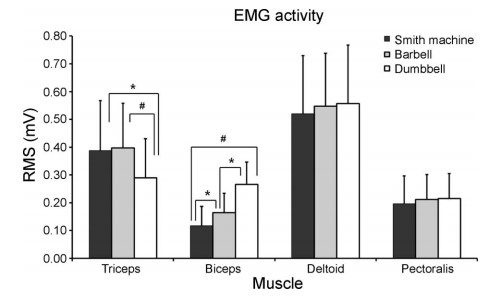
As we can see in the graph, in the barbell bench press and Smith machine, the muscle activation of the triceps brachii is greater than in the dumbbell press (3).
On the contrary, the dumbbell press was the exercise where the biceps brachii had a higher percentage of activation, followed by the barbell bench press and lastly the Smith machine bench press (3).
Muscle activation in the eccentric phase of the dumbbell press
In the eccentric phase, differences were seen in the muscle activation of the biceps brachii, pectoralis major, and anterior deltoid between the dumbbell press, barbell bench press, and Smith machine bench press (3).
In the eccentric phase of the dumbbell press, the muscle activation of the pectoralis major, anterior deltoid, and biceps brachii was greater than that of the Smith machine bench press (3).
The muscle activation in the eccentric phase of the mentioned muscles was similar in both the dumbbell press and the barbell bench press (3).
There were no significant differences in the muscle activation of the eccentric phase for the triceps brachii (3).
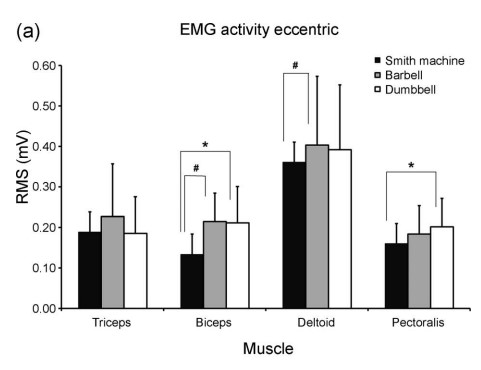
Muscle activation in the concentric phase of the dumbbell press
On the other hand, in the concentric phase, differences can be seen in the muscle activation of the biceps brachii and the triceps brachii (3).
The muscle activation of the triceps brachii was lower in the dumbbell press compared to the barbell bench press and the Smith machine bench press (3).
However, the muscle activation of the biceps brachii was greater in the dumbbell press compared to the Smith machine bench press and the barbell bench press (3).
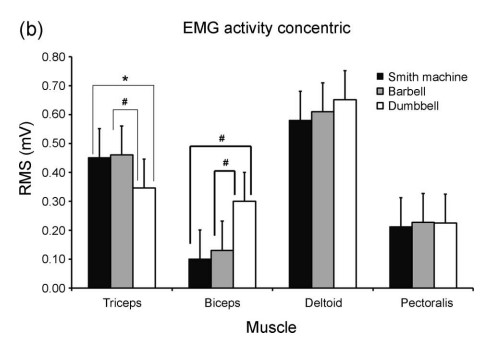
Dumbbell press and RM
Saeterbakken et al. (2010) observed in their study that in the dumbbell press, a lower RM is obtained compared to the barbell bench press or Smith machine (3).
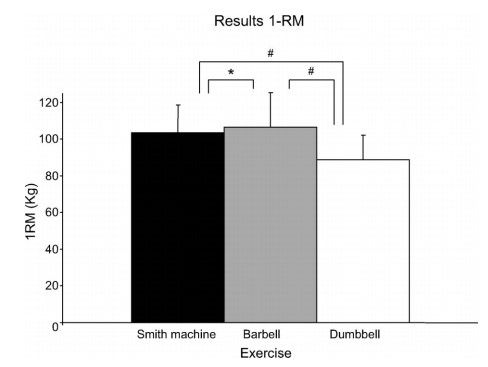
Conclusions
After analyzing the study by Saeterbakken et al. (2010), we can conclude that during the execution of the dumbbell press at an intensity of 1-RM, there are differences in terms of muscle activation of the biceps brachii and the triceps brachii compared to the barbell bench press and Smith machine.
However, there are no significant differences in the muscle activation of the anterior deltoid and pectoralis major when comparing the 3 exercises mentioned above.
Muscle activation in the dumbbell press on stable and unstable surfaces
Currently, the use of unstable materials like bosu balls and fitballs in strength training exercises is very popular.
Next, we will see the results of a study by Uribe et al. (2010) where the dumbbell press was performed with the scapulae supported on a fitball (unstable surface) and the dumbbell press on a bench (stable surface) with a load of 80% of 1-RM.
After reviewing the muscle activation of the anterior deltoid, pectoralis major, and rectus abdominis during the dumbbell press on stable and unstable surfaces, no significant differences were seen, neither in the eccentric phase nor in the concentric phase (4).

It is worth noting that in another study by Marshall and Murphy (2006), a greater activation of the anterior deltoid was observed during the dumbbell press on an unstable surface. This was because the subject had the fitball supported in the thoracolumbar area instead of the scapular area.
The authors concluded that placing the fitball in the thoracolumbar area caused the scapulohumeral muscles like the anterior deltoid to activate more to stabilize the joint (1).
Therefore, depending on the area where the back is supported on the fitball in the dumbbell press, there may or may not be differences in muscle activation.
Differences between unilateral and bilateral dumbbell press
In a study by Patterson, Vigotsky, Oppenheimer, and Feser (2015), they wanted to analyze the muscle activation of different muscles involved in the dumbbell press, executing it unilaterally (with one dumbbell) and bilaterally (with two dumbbells).
Additionally, they also compared the activation using a COR bench and a flat bench. The COR bench is a bench that offers some instability compared to the conventional flat bench.
Patterson et al. (2015) did not observe significant differences during the execution of the exercise bilaterally and unilaterally between any of the mentioned benches.
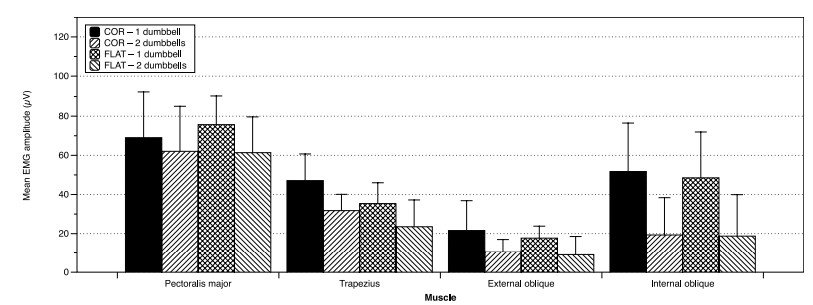
Regarding ROM, performing the dumbbell press unilaterally on the COR bench achieves a greater range of motion during the exercise compared to the bilateral dumbbell press on the COR bench (2).

The fact that the COR bench has some curvature helps to have that extra range of motion in the dumbbell press (2).
However, there were no significant differences in terms of ROM between the unilateral and bilateral exercise between the COR bench and the flat bench (2).
Therefore, the use of a COR bench (more unstable) does not help achieve higher levels of muscle activation compared to a flat bench in the dumbbell press (2).
However, the use of the COR bench does help achieve a greater ROM during the unilateral dumbbell press. This aspect could be interesting for use in injury rehabilitation or for improving sports performance, as unilateral work is recommended in these areas (2).
Conclusions
In the dumbbell press, the muscle activation of the triceps brachii is lower than in the bench press.
The dumbbell press was the exercise where the biceps brachii had a higher percentage of activation, followed by the barbell bench press and lastly the Smith machine bench press.
In the eccentric phase of the dumbbell press, the muscle activation of the pectoralis major, anterior deltoid, and biceps brachii is greater than that of the Smith machine bench press but similar to that observed in the barbell bench press.
The dumbbell press could be a good exercise for rehabilitation and injury readaptation phases, as large percentages of muscle activation occur with little weight.
With the dumbbell press, a lower percentage of RM is obtained compared to the barbell bench press and the Smith machine bench press. Therefore, for strength training, it would be advisable to opt for the barbell bench press or the Smith machine.
Since it is not guided, in the dumbbell press there is greater ROM and greater tension in the eccentric phase.
Performing the dumbbell press on an unstable surface does not show significant differences compared to performing it on a stable surface. However, depending on the area of the back where we support the fitball, differences in muscle activation may occur.
Course on Muscle Hypertrophy
If you want to learn more about the Barbell Row and how to get the most out of your workouts, we recommend our Course on Muscle Hypertrophy, based on the latest scientific studies.
Bibliographic references
- Marshall, PW and Murphy, BA. Increased deltoid and abdominal muscle activity during swiss ball bench press. J Strength Cond Res 20: 745–750, 2006.
- Patterson et al. (2015). Differences in unilateral chest press muscle activation and kinematics on a stable versus unstable surface while holding one versus two dumbbells. PeerJ 3:e1365; DOI 10.7717/peerj.1365
- Saeterbakken AH, van den Tillaar R, Fimland MS. A comparison of muscle activity and 1-RM strength of three chest-press exercises with different stability requirements. J Sports Sci. 2011 Mar;29(5):533-8. doi: 10.1080/02640414.2010.543916. PMID: 21225489.
- Uribe BP, Coburn JW, Brown LE, Judelson DA, Khamoui AV, Nguyen D. Muscle activation when performing the chest press and shoulder press on a stable bench vs. a Swiss ball. J Strength Cond Res. 2010 Apr;24(4):1028-33. doi: 10.1519/JSC.0b013e3181ca4fb8. PMID: 20300023.
